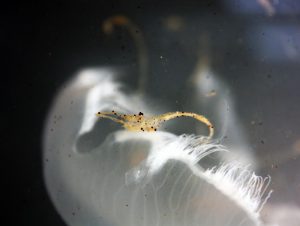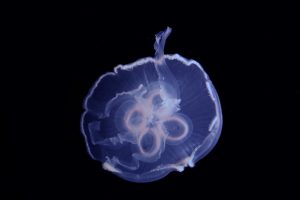Study Finds Jellyfish Mucus May Enhance Microbial Oil Biodegradation
– MARCH 23, 2017
Scientists conducted laboratory experiments to examine the influence of moon jellyfish (Aurelia aurita) on crude oil aggregation and degradation. The researchers found that jellyfish swimming in a dispersed oil solution produced copious amounts of mucus which formed aggregates containing 26 times more oil than the surrounding water. Hydrocarbon-degrading bacteria density more than doubled and microbial oil degradation significantly increased compared to control treatments. These results suggest that jellyfish can aggregate dispersed oil droplets beyond water column concentrations and embed them in an environment that favors oil-degrading bacteria. The scientists published their findings in Marine Pollution Bulletin: Can gelatinous zooplankton influence the fate of crude oil in marine environments?
Gelatinous zooplankton excrete a nutrient-rich mucus that other organisms can use. Environmental stressors, such as an oil-spill plume interacting with zooplankton, exacerbate mucus excretion. The increased mucus may boost oil biodegradation by enhancing nitrogen and phosphorus availability, which bacteria need to degrade oil but are often limited during a spill event.
Researchers conducted ten trials with moon jellyfish collected from inshore northern Gulf of Mexico waters using seawater and an emulsified suspension of crude oil droplets. Experiments with jellyfish swimming in the presence of crude oil used 100 uL/L oil concentration to simulate a sub-surface oil plume (a concentration based on Reddy, et al., 2012 who measured the xylene fraction above the Macondo well and found up to 80 uL/L of total crude oil). The team evaluated the effects of jellyfish mucus on bacterial growth and oil biodegradation using batch culture experiments with 1000 uL/L oil concentration (based on prior work with bacteria and oil Bacosa, et al., 2012). Then they analyzed images of the mucus aggregates the jellyfish created and shed to evaluate effects on bacterial growth and oil biodegradation.
Jellyfish in control seawater treatments did not produce mucus, while jellyfish in crude oil treatments produced mucus in less than one minute after oil was introduced, and this mucus may have inhibited the jellyfish ingesting or absorbing oil. The amount of oil that the mucus contained correlated linearly with the size of the mucus aggregates. The density of oil-degrading bacteria more than tripled after 7 days compared to the non-mucus control, and n-alkane hydrocarbons decreased 33% after 14 days. The authors hypothesized that the increased nitrogen availability due to jellyfish mucus could explain the higher microbial oil degradation rate.
The results suggest that the bacterial response to crude oil and jellyfish mucus may have important implications for oil spill fate in areas where zooplankton are abundant. The researchers propose larger-scale studies be carried out to better understand these processes under more realistic conditions.
GoMRI data are publicly available through the Gulf of Mexico Research Initiative Information and Data Cooperative (GRIIDC) at doi:10.7266/N71834JF.
The study’s authors are Brad J. Gemmell, Hernando P. Bacosa, Zhanfei Liu, and Edward J. Buskey.
************
This research was made possible in part by a grant from the Gulf of Mexico Research Initiative (GoMRI) to the Dispersion Research on Oil: Physics and Plankton Studies II (DROPPS II) consortium.
The Gulf of Mexico Research Initiative (GoMRI) is a 10-year independent research program established to study the effect, and the potential associated impact, of hydrocarbon releases on the environment and public health, as well as to develop improved spill mitigation, oil detection, characterization and remediation technologies. An independent and academic 20-member Research Board makes the funding and research direction decisions to ensure the intellectual quality, effectiveness and academic independence of the GoMRI research. All research data, findings and publications will be made publicly available. The program was established through a $500 million financial commitment from BP. For more information, visit https://gulfresearchinitiative.org/.
© Copyright 2010-2017 Gulf of Mexico Research Initiative (GoMRI) – All Rights Reserved. Redistribution is encouraged with acknowledgement to the Gulf of Mexico Research Initiative (GoMRI). Please credit images and/or videos as done in each article. Questions? Contact web-content editor Nilde “Maggie” Dannreuther, Northern Gulf Institute, Mississippi State University (maggied@ngi.msstate.edu).







